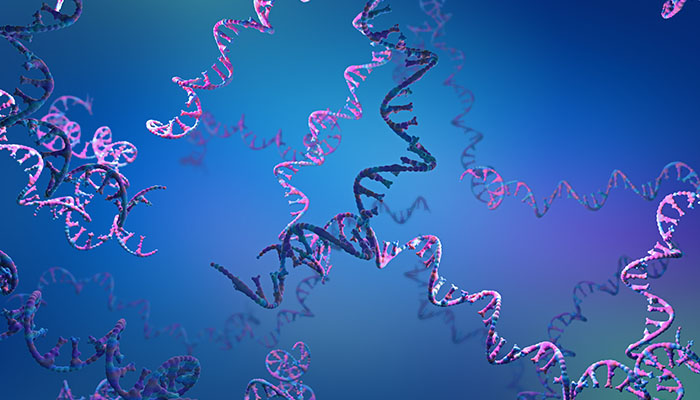HOW CAN WE HELP YOU? Call 1-800-TRY-CHOP
In This Section
NIH New Innovator Award Supports Search for Answers in Splicing Codes and Cancer

Peter Choi, PhD, 2021 recipient of the NIH Director’s New Innovator Award.
limjr [at] chop.edu (By Jillian Rose Lim)
RNA splicing, in which parts of our gene’s “text” are stitched and seamed together, is an essential process for turning the rough blueprint of DNA into messenger RNA (mRNA). While scientists have long observed that this process appears highly dysregulated in cancer and other diseases, fundamental questions remain as to why. Motivated to unravel the mysteries of this process, Children’s Hospital of Philadelphia scientist Peter Choi, PhD, studies splicing and the many layers of information involved in its regulation.
With support from a 2021 National Institutes of Health (NIH) Director’s New Innovator Award, Dr. Choi has embarked on a mission to learn how the regulation of splicing might intersect with epigenetics to produce healthy or diseased outcomes. The prestigious award, described by the NIH as an opportunity for “unusually creative early stage innovators,” is part of the NIH Common Fund’s High Risk, High Reward Research Program, the spirit of which Dr. Choi’s project embodies.

“It always comes back to understanding cancer,” said Dr. Choi, whose $1.5 million award stretches over a five-year period. “I’m interested in the genetics of cancer, and within that broad field, I focus on RNA-binding proteins that interact with and regulate RNA within the cell. Scientists have observed for a long time that splicing is quite abnormal in cancer cells, but the fact that the proteins that regulate RNA splicing are also found mutated really opened up a whole new area to explore. So, this project is focused on the basic question, ‘what information goes into regulating slicing?’ We want to understand that at a very basic level so that in the context of cancer, we can understand why we see those differences.”
Splicing 101
A quick primer on splicing: As an RNA copy is transcribed from a gene’s DNA sequence, the resulting messenger RNA (mRNA) molecules must be processed, or “spliced.” This means that once a gene’s text is scanned, coding sequences called exons are joined together and non-coding sequences called introns are removed – producing a mature messenger transcript that can then direct protein production. Though this process has been studied for decades, Dr. Choi is particularly interested in understanding all of the information that controls this operation – the many complex layers that comprise the splicing code.
“The information behind the splicing code is provided at many levels – one being the sequence itself,” Dr. Choi said. “But it turns out that looking at the sequence alone is not enough for us to predict or say, these exons are always joined together.”
So, to further understand how splicing is regulated or dysregulated, Dr. Choi analyzes the behavior of RNA-binding proteins that interact with RNA and regulate how and which exons are joined. But he doesn’t stop there: Dr. Choi also weaves in what might be happening on the DNA level – that is, epigenetic regulation. Epigenetics describes changes in how the cell reads a DNA sequence that can result in the switching on or off of genes.
Where Epigenetics and RNA Splicing Meet
“We often think of splicing and transcription as separate steps,” Dr. Choi said. “But while RNA is being transcribed from DNA, the splicing process can actually occur at the same time. So, even though the entire mRNA molecule is not yet fully made, as it’s being produced, exons are being joined.
“A lot of work has shown these processes occur together, and because of that, they can influence each other. So, in terms of the splicing code, we think of the sequence, the RNA-binding proteins, and then the influence of epigenetics. This project seeks to explore that last layer of the code.”
To study this least understood layer of influence, Dr. Choi’s lab developed approaches that enable them to connect a particular type of splicing as it occurs with proteins on DNA called histones. Histones, which are epigenetic regulators, have particular observable modifications and Dr. Choi is interested in the specific type of modifications that relate to splicing.
The New Innovator project, experimental and innovative in its nature, will build the foundation for understanding how splicing codes and their determinants diverge in cases of cancer. Since scientists can’t exactly point to what may be responsible for splicing differences, Dr. Choi aims to understand how splicing is regulated normally, and from there begin to put the information in a disease context.
“You can’t identify what’s going wrong until you understand all the pieces,” Dr. Choi said. “We hope by learning more about how splicing works normally, then we can answer the question of how exactly it goes wrong and identify whether there is something we can target.”
Dr. Choi is thankful for the opportunity provided by the award and looks forward to addressing the gaps in knowledge we currently have about complex splicing codes.
“I feel incredibly lucky to receive this award,” said Dr. Choi. “This idea is quite risky but it really follows along with the whole spirit of the grant. And I think as young investigators, it’s usually better to play it safe but this grant really gives us a chance to try something much riskier, so we’re excited to be able to do that.”